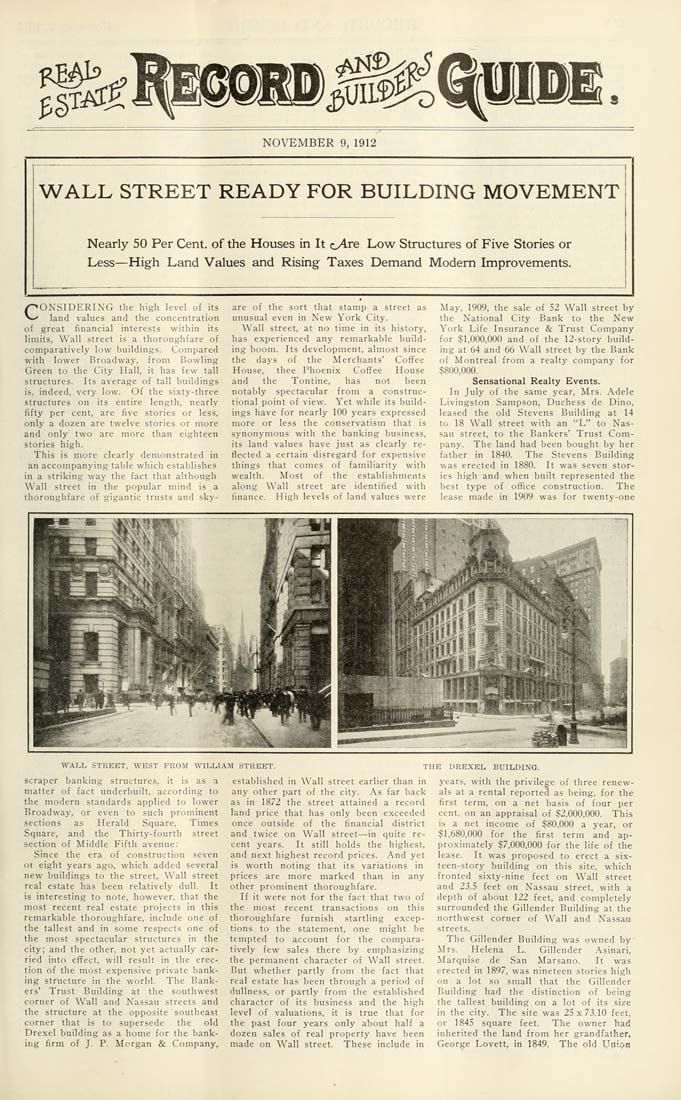Columbia University Libraries Digital Collections: The Real Estate Record
Use your browser's Print function to print these pages.
Real estate record and builders' guide: [v. 90, no. 2330]: November 9, 1912

Text version:
Please note: this text may be incomplete. For more information about this OCR, view About OCR text.
*^^/m m^: NOVEMBER 9, 1912 WALL STREET READY FOR BUILDING MOVEMENT Nearly 50 Per Cent, of the Houses in It c/4re Low Structiores of Five Stories or Less—High Land Values and Rising Taxes Demand Modem Improvements. CONSIDERING the high level of its land values and the concentration of great financial interests within its limits, Wall street is a thoroughfare of comparatively low buildings. Compared ■with lower Broadway, from Bowling Green to the City Hall, it has few tall structures. Its average of tall buildings is, indeed, very low. Of the sixty-three structures on its entire length, nearly fifty per cent, are five stories or less, only a dozen are twelve stories or more and only two are more than eighteen stories high. This is more clearly demonstrated in an accompanying table which establishes in a striking way the fact that although Wall street in the popular mind is a thoroughfare of gigantic trusts and sky- are of the sort that stamp a street as unusual even in New York City. Wall street, at no time in its history, has experienced any remarkable build¬ ing boom. Its development, almost since the days of the Merchants' Coflfee House, thee Phoenix Coffee House and the Tontine, has not been notably spectacular from a construc¬ tional point of view. Yet while its build¬ ings have for nearly 100 years expressed more or less the conservatism that is synonymous with the banking business, its land values have just as clearly re¬ flected a certain disregard for expensive things that comes of familiarity with wealth. Most of the establishments along Wall street are identified with finance. High levels of land values were May, 1909, the sale of 52 Wall street by the National City Bank to the New York Life Insurance & Trust Company for $1,000,000 and of the 12-story build¬ ing at 64 and 66 Wall street by the Bank of Montreal from a realty company for $800,000. Sensational Realty Events. In July of the same year, Mrs. Adele Livingston Sampson, Duchess de Dino, leased the old Stevens Building at 14 to 18 Wall street with an "L" to Nas¬ sau street, to the Bankers' Trust Com¬ pany. The land had been bought by her father in 1840. The Stevens Building ■was erected in 1880. It was seven stor¬ ies high and when built represented the best type of office construction. The lease made in 1909 was for twenty-one WALL STREET, WEST FROM WILLIAM STREET. THE DREXEL BUILDING. scraper banking structures, it is as a matter of fact underbuilt, according to the modern standards applied to lower Broadway, or even to such prominent sections as Herald Square, Times Square, and the Thirty-fourth street section of Middle Fifth avenue: Since the era of construction seven ot eight years ago, which added several new buiWings to the street, Wall street real estate has been relatively dull. It is interesting to note, however, that the most recent real estate projects in this remarkable thoroughfare, include one of the tallest and in some respects one of the most spectacular structures in the city; and the other, not yet actually car¬ ried into effect, will result in the erec¬ tion of the most expensive private bank¬ ing structure in the world. The Bank¬ ers' Trust Building at the southwest corner of Wall and Nassau streets and the structure at the opposite southeast corner that is to supersede the old Drexel building as a home for the bank¬ ing firm of J. P. Morgan & Company, established in Wall street earlier than in any other part of the city. As far back as in 1872 the street attained a record land price that has only been exceeded once outside of the financial district and twice on Wall street—in quite re¬ cent years. It still holds the highest, and next highest record prices. And yet is worth noting that its variations in prices are more marked than in any other prominent thoroughfare. If it were not for the fact that two of the most recent transactions on this thoroughfare furnish startling excep¬ tions to the statement, one might be tempted to account for the compara¬ tively few sales there by emphasizing the permanent character of Wall street. But whether partly from the fact that real estate has been through a period of dullness, or partly from the established character of its business and the high level of valuations, it is true that for the past four years only about half a dozen sales of real property have been made on Wall street. These include in years, with the privilege of three renew¬ als at a rental reported as being, for the first term, on a net basis of four per cent, on an appraisal of $2,000,000. This is a net income of $80,000 a year, or $1,680,000 for the first term and ap¬ proximately $7,000,000 for the life of the lease. It was proposed to erect a six¬ teen-story building on this site, which fronted sixty-nine feet on Wall street and 23.5 feet on Nassau street, with a depth of about 122 feet, and completely surrounded the Gillender Building at the northwest corner of Wall and Nassau streets. The Gillender Building was owned by Mrs. Helena L. Gillender Asinari, Marquise de San Marsano. It was erected in 1897, was nineteen stories high on a lot so small that the Gillender Building had the distinction of being the tallest building on a lot of its size in the city. The site was 25 x 73.10 feet, or 1845 square feet. The owner had inherited the land from her grandfather, George Lovett, in 1849, The old Union